Background

American toad
Amphibian populations are declining worldwide and environmental contaminants are an important contributing factor. Although the transfer of contaminants from a female to her offspring has been studied in many fish and wildlife species, this process is grossly understudied in amphibians. Maternal transfer of contaminants may be an overlooked mechanism of impaired reproductive success by directly affecting reproduction of individuals, which could influence local population dynamics. Our work is the first to document amphibian maternal transfer of mercury (Hg) in a tissue residue-dependent manner. Mercury is a pollutant of global concern due to its ubiquity, toxicity, and ability to bioaccumulate and biomagnify in food webs. Consequently, our research objectives are to:
- Examine the individual and interactive effects of maternally- and trophically-derived Hg on growth and development in amphibian embryos, larvae, and post-metamorphic juveniles.
- Use the data generated from these studies to project the impact of Hg on amphibian population growth rates.
- Examine these effects across Hg concentrations that span orders of magnitude so that our findings will be applicable to systems with various levels of Hg contamination.
Experimental Approach
We are using the American toad, Bufo americanus, as a model species for our work. We are using a combination of field and laboratory techniques such as experimental Hg-contaminated and control diets, aquatic mesocosms, and terrestrial enclosures to determine immediate and latent effects of Hg contamination on:
- female reproductive success
- major embryonic and larval life history characteristics (e.g., survival to metamorphosis)
- juvenile recruitment to, and survival in, the terrestrial environment. This information will be used to generate stage-based population models to project the impact of maternally transferred and trophically-derived Hg on population growth rates.
Expected Results
Our research will directly link a female’s previous Hg exposure to the Hg concentration in her eggs, her reproductive success, and the developmental success of her offspring. By combining field and laboratory approaches, our research will determine the relative importance of maternally-derived Hg versus continued trophic exposure of larvae on female reproductive success and the ecological significance of compromised reproduction. The large range in Hg concentrations in amphibians along a contamination gradient at our study site will allow us to determine threshold concentrations for adverse effects for individuals, and to estimate population-level impacts of varying Hg concentrations based on projections from our models. Since toxicity thresholds have not been established for any contaminant in an amphibian species, our research will be fundamental for conservation and management decisions for these sensitive vertebrates.
